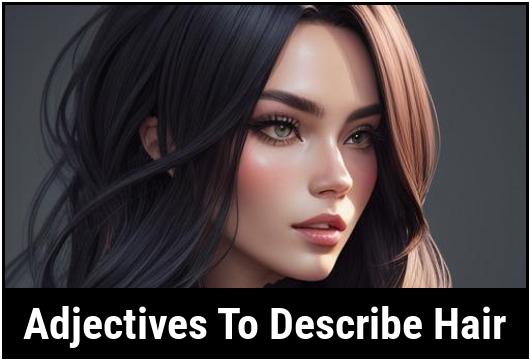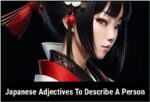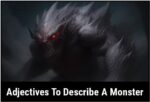- You are here:
- Home »
- adjectives
- » 31 Adjectives To Describe Hair

31 Adjectives To Describe Hair
Hair is a defining feature of a person’s appearance, and it comes in a multitude of textures, colors, and styles. Describing hair using adjectives can paint a vivid picture and convey the distinct characteristics of an individual’s hair. Whether it’s silky, curly, unruly, or vibrant, adjectives play a crucial role in capturing the essence of hair and its unique attributes.
Key Takeaways
- Adjectives are powerful tools for vividly describing the texture, color, length, and overall quality of hair.
- Choosing the right adjectives can effectively convey the desired image and impression of a person’s hair.
- There are various types of adjectives that can be used to describe different aspects of hair, including texture, color, and style.
Adjectives To Describe Hair
1. Lustrous
Hair that is lustrous has a radiant shine that captures attention. It reflects light beautifully, adding a stunning and glamorous touch to your overall appearance.
2. Silky
Silky hair feels incredibly soft and smooth to the touch. It is delicate and fine, resembling the touch of silk fabric. This adjective evokes a sense of luxury and elegance.
3. Glossy
Glossy hair has a polished look, appearing healthy and well-conditioned. The shine is consistent throughout, giving your locks a stunning sheen that stands out wherever you go.
4. Voluminous
Voluminous hair has exceptional body and fullness, creating a dynamic and bouncy effect. This adjective is often associated with a glamorous and dramatic hairstyle that turns heads.
5. Bouncy
Bouncy hair has a natural spring and buoyancy. It lends an energetic and lively appearance to your overall look, enhancing your confidence and charisma.
6. Wavy
Wavy hair possesses gentle, effortless waves that cascade beautifully. This adjective describes hair that has a subtle, relaxed texture, giving it a carefree and romantic vibe.
7. Shimmering
Shimmering hair produces a subtle glimmer as it catches the light. This adjective is perfect for hair that exhibits a radiant, iridescent quality, adding a touch of magic and allure to your presence.
8. Tousled
Tousled hair has a slightly disheveled, bedhead look that exudes an alluring and carefree charm. This adjective is often associated with a relaxed and effortlessly stylish appearance.
9. Vibrant
Vibrant hair possesses bold and intense hues that radiate energy and enthusiasm. Whether it’s a vivid shade of red, blue, or any other color, vibrant hair expresses a lively and vivacious personality.
10. Shiny
Shiny hair reflects light brilliantly, appearing healthy and well-maintained. It has a smooth and gleaming surface that hints at the time and effort put into its care.
11. Straight
Straight hair is smooth and sleek, flowing effortlessly from the roots to the ends. This adjective characterizes hair that lacks any significant curls or waves, giving it an elegant and sophisticated appearance.
12. Flawless
Flawless hair is immaculate, without any frizz, split ends, or damage. This adjective describes hair that appears perfect and well-groomed, radiating an aura of meticulousness and attention to detail.
13. Shimmering
Shimmering hair produces a subtle glimmer as it catches the light. This adjective is perfect for hair that exhibits a radiant, iridescent quality, adding a touch of magic and allure to your presence.
14. Glossy
Glossy hair has a polished look, appearing healthy and well-conditioned. The shine is consistent throughout, giving your locks a stunning sheen that stands out wherever you go.
15. Curly
Curly hair is characterized by well-defined loops or coils. It has a playful and lively nature, representing warmth and a vibrant personality.
16. Flowing
Flowing hair moves gently with grace and fluidity. This adjective describes hair that appears to be in constant motion, adding an element of elegance and sophistication to your overall look.
17. Textured
Textured hair exhibits depth and dimension. It has a unique structure that sets it apart, making it interesting and visually appealing. This adjective is often used to describe hair that has twists, kinks, or natural waves.
18. Luscious
Luscious hair is thick, healthy, and abundant. It creates a sense of opulence and vitality, symbolizing natural beauty and strength.
19. Shaggy
Shaggy hair has a deliberately messy and unkempt appearance. This adjective characterizes hair that is intentionally styled to appear carefree and effortlessly chic.
20. Sleek
Sleek hair is straight, smooth, and impeccably styled. It embodies a sense of sophistication and polish, reflecting an individual who takes pride in their appearance and pays attention to detail.
21. Wild
Wild hair has an untamed and free-spirited quality. It represents a carefree and adventurous personality, inviting others to embrace their natural side.
22. Thick
Thick hair possesses a generous amount of strands, resulting in a voluminous and luxurious appearance. This adjective characterizes hair that appears dense and full of life.
23. Fine
Fine hair is delicate and has a subtle texture. Although it may not possess as much volume as other types, it still exudes elegance and refinement, providing a neat and polished look.
24. Shapely
Shapely hair has a defined and well-maintained structure. It appears neatly styled and carefully shaped, giving it an attractive and visually appealing form.
25. Frizz-free
Frizz-free hair remains smooth and well-behaved, even in humid or challenging environments. This adjective illustrates hair that is expertly managed and appears effortlessly flawless.
26. Geometric
Geometric hair has precise and defined lines, often styled in intricate patterns. This adjective characterizes hair that is meticulously shaped and arranged, showcasing artistic creativity and attention to detail.
27. Layered
Layered hair is cut in a manner that creates various lengths and dimensions. This adjective describes hair that has distinct sections, lending depth and movement to your overall look.
28. Effortless
Effortless hair appears stylish and put-together without appearing forced or overdone. It embraces a natural and easygoing aesthetic, emphasizing simplicity and casual elegance.
29. Radiant
Radiant hair glows with health and vitality. It looks nourished and well-maintained, projecting a positive and energetic aura.
30. Regal
Regal hair has an elegant and majestic quality. It embodies grace and sophistication, giving its wearer an air of nobility and distinction.
31. Irresistible
Irresistible hair has an undeniable allure and enchantment. It captivates and fascinates those around you, making it impossible to resist your charm and charisma.
Why Use Adjectives To Describe Hair
Using adjectives to describe hair is essential for effectively communicating its characteristics. Whether it’s in a casual conversation, a professional setting, or in creative writing, adjectives provide a means to vividly illustrate the details of hair. Descriptive language enhances communication and helps in creating a clear mental image of the hair’s appearance.
Adjectives also allow individuals to express their personal style and preferences when discussing or portraying their hair. They can evoke emotions and evoke specific mental images, contributing to a deeper understanding and appreciation of the diversity and beauty of different hair types.
How To Choose The Right Adjective To Describe Hair
When choosing adjectives to describe hair, it’s important to consider the specific characteristics that need to be conveyed. Factors such as texture, color, length, and style play a crucial role in determining the appropriate adjectives. Additionally, considering the context and the intended effect of the description is essential in selecting the right adjectives.
It’s also important to be mindful of the connotations associated with certain adjectives. For example, words like "wild" or "frizzy" may have negative associations, while "vibrant" or "lustrous" carry positive connotations. Understanding the nuances of different adjectives can help in capturing the desired impression while describing hair.
Types Of Adjectives For Describing Hair
1. Texture Adjectives
Texture adjectives describe the feel and appearance of the hair strands. They convey whether the hair is smooth, rough, coarse, or soft. Some common texture adjectives for describing hair include:
- Silky: Hair that is smooth, lustrous, and luxuriously soft to the touch.
- Coarse: Hair that is rough or coarse in texture, often thicker and more resistant to styling.
- Frizzy: Hair that is characterized by small, tight curls or waves, often appearing unruly or fluffy.
- Tangled: Hair that is twisted or knotted together, often difficult to comb through and manage.
2. Color Adjectives
Color adjectives are used to describe the hue and tone of the hair. They encompass the diverse spectrum of hair colors, ranging from natural shades to vibrant dyes. Some examples of color adjectives for describing hair include:
- Blonde: Hair that is light in color, often ranging from golden to pale yellow tones.
- Brunette: Hair that is dark brown in color, typically associated with shades of brown and chestnut.
- Auburn: Hair that has reddish-brown tones, resembling the color of autumn leaves.
- Jet-black: Hair that is deeply pigmented and appears very dark, like the color of jet.
3. Length Adjectives
Length adjectives pertain to the overall long or short nature of the hair. They convey the physical extent of the hair strands and can vary from short to long, or even varying lengths within a specific hairstyle. Some common length adjectives for describing hair include:
- Flowing: Hair that is long and cascading, often giving the impression of movement and elegance.
- Cropped: Hair that is cut short, typically close to the head, giving a neat and defined appearance.
- Shoulder-length: Hair that extends to or falls around the shoulders, creating a balanced and versatile look.
- Pixie: Hair that is very short, often styled close to the scalp, giving an edgy and youthful appearance.
4. Style Adjectives
Style adjectives describe the overall appearance and arrangement of the hair. They convey how the hair has been styled, whether it’s sleek, voluminous, or intricately designed. Some style adjectives for describing hair include:
- Sleek: Hair that is smooth, straight, and polished, often reflecting light and appearing well-groomed.
- Voluminous: Hair that is full and bouncy, often having a lot of body and thickness.
- Layered: Hair that is cut with varying lengths to create dimension and movement, often enhancing the overall texture and style.
- Braided: Hair that is intricately woven into braids, creating a structured and decorative look.
Adjectives play a vital role in vividly describing the diverse qualities of hair, including texture, color, length, and style. By carefully selecting the right adjectives, individuals can effectively convey the unique characteristics of their hair, express their personal style, and evoke specific mental images. Whether it’s silky, vibrant, flowing, or braided, adjectives help in capturing the essence of hair and celebrating its beauty in all its forms.
Examples Of Adjectives For Different Types Of Hair
When it comes to describing hair, there are countless adjectives that can be used to capture its texture, color, length, and overall appearance. Adjectives play a crucial role in painting a vivid picture and conveying the unique characteristics of someone’s hair. Whether you have long, flowing locks or short, curly hair, there is an adjective out there that can perfectly describe your tresses.
1. Straight Hair
- Sleek: Straight hair that is smooth and glossy.
- Lustrous: Shiny and radiant straight hair.
- Silky: Soft and smooth straight hair that is reminiscent of silk.
- Poker-straight: Hair that is perfectly straight without any curls or waves.
- Polished: Straight hair that appears well-groomed and refined.
2. Wavy Hair
- Tousled: Hair with gentle waves that appear effortlessly messy or disheveled.
- Beachy: Hair that mimics the natural waves achieved from spending time at the beach.
- Cascading: Wavy hair that falls in gentle, flowing waves.
- Undulating: Hair with gentle and continuous waves, resembling soft ripples.
- Voluminous: Full-bodied wavy hair that adds depth and thickness to the overall appearance.
3. Curly Hair
- Bouncy: Curly hair that has a lively and playful bounce.
- Ringlet: Defined and perfectly formed curls that resemble rings or coils.
- Spiral: Curly hair with distinct and well-defined spiral-shaped curls.
- Frizzy: Curly hair that appears unruly and prone to frizz.
- Wild: Unruly and untamed curly hair.
4. Coily/Kinky Hair
- Coiled: Tight, spring-like curls that are densely packed together.
- Afro-textured: Hair characterized by its natural tight curls and volume.
- Natural: Hair that is not chemically treated or straightened, showcasing its natural texture.
- Tightly coiled: Hair with tightly packed and defined curls.
- Shrinkage: Hair that appears much shorter when dry due to the tightness of the curls.
5. Thick Hair
- Voluminous: Hair that is full-bodied and adds depth and thickness to the overall appearance.
- Luxurious: Abundant and opulent hair that has a rich and lavish appearance.
- Dense: Hair that is tightly packed and has a lot of strands per square inch.
- Full: Hair that appears complete and abundant with no visible scalp.
- Plush: Hair that feels soft and luxurious to the touch.
6. Thin Hair
- Fine: Hair that has a smaller diameter and is less voluminous.
- Limp: Hair that lacks volume and appears flat or lifeless.
- Sparse: Hair with few strands per square inch, resulting in a less dense appearance.
- Thinning: Hair that is gradually becoming sparser and losing its fullness.
- Wispy: Thin, delicate strands of hair that give a feathery appearance.
7. Long Hair
- Flowing: Hair that cascades down in a beautiful and graceful manner.
- Rapunzel-like: Extremely long hair, reminiscent of the fairy tale character Rapunzel.
- Luscious: Glossy, healthy, and visually appealing long hair.
- Cascading: Hair that falls in gentle, flowing waves, creating a cascading effect.
- Rapunzel-like: Extremely long hair, reminiscent of the fairy tale character Rapunzel.
8. Short Hair
- Chic: Short hair that is stylish and fashionable.
- Edgy: Short hair with a bold and unconventional style.
- Cropped: Hair that has been cut short, typically in a uniform length.
- Neat: Short hair that is well-groomed and tidy in appearance.
- Low-maintenance: Short hair that requires minimal effort to style and maintain.
These are just a few examples of adjectives that can be used to describe different types of hair. Keep in mind that the possibilities are endless, and you can mix and match adjectives to create unique descriptions that capture the essence of someone’s hair.
Common Mistakes In Using Adjectives To Describe Hair
When using adjectives to describe hair, it is important to keep a few common mistakes in mind to ensure accurate and effective use of the language. Avoiding these mistakes will help you create more precise and descriptive descriptions of someone’s hair.
1. Overusing Generic Adjectives
Generic adjectives like "nice," "beautiful," or "pretty" can be used to describe almost anything, including hair. However, they lack specificity and fail to capture the unique characteristics of someone’s hair. Instead, try to use more descriptive adjectives that paint a vivid picture in the reader’s mind.
Incorrect: She Has Nice Hair.
Correct: She Has Lustrous, Silky Hair.
2. Using Incorrect Adjectives
It is essential to use adjectives that accurately describe the type and texture of the hair. Using incorrect adjectives can lead to confusion or provide an inaccurate representation of someone’s hair.
Incorrect: She Has Wavy Hair, But It’s Actually Straight.
Correct: She Has Straight Hair.
3. Failing To Consider The Context
The context in which the hair is being described is crucial. Certain adjectives may be appropriate in one context but not in another. Consider the overall appearance, personality, and specific situation when selecting the adjectives.
Incorrect: Her Wild Hair Was Perfect For The Corporate Meeting.
Correct: Her Stylishly Tousled Hair Was Perfect For The Casual Outing.
4. Neglecting To Consider Hair Changes
Hair is a dynamic feature that can be manipulated through styling, heat treatments, or chemical processes. It is important to consider the current state of someone’s hair when using adjectives to describe it accurately.
Incorrect: His Frizzy Hair Looked Sleek And Smooth.
Correct: His Smoothed-out Frizzy Hair Looked Sleek And Smooth.
Using Adjectives Effectively
To use adjectives effectively and create more compelling descriptions of someone’s hair, consider the following tips:
1. Be Specific And Precise
Instead of using generic adjectives, try to choose more specific and precise ones that accurately capture the characteristics of the hair. For example, instead of saying "She has beautiful hair," you could say "She has lustrous, cascading waves of chestnut hair."
2. Use Sensory Language
Incorporate sensory language to engage the reader’s senses and create a more immersive experience. Consider how the hair feels, looks, and even smells, and use adjectives that reflect these sensory experiences. For example, instead of simply saying "She has curly hair," you could say "Her bouncy, fragrant curls framed her face."
3. Consider The Context And Purpose
Think about the purpose of your description and the context in which the hair is being described. Are you trying to evoke a certain emotion or create a specific image in the reader’s mind? Tailor your adjectives accordingly to achieve your desired effect.
4. Take Into Account Personal Preferences
Remember that beauty is subjective, and what one person finds attractive in someone’s hair may differ from another’s opinion. Consider the personal preferences of the character or individual being described when selecting adjectives to ensure authenticity.
5. Use Figurative Language
Incorporate metaphors, similes, or other forms of figurative language to add depth and creativity to your descriptions. Comparing someone’s hair to something else can create a powerful visual image and evoke emotions in the reader. For example, you could say "Her curls were as tight as springs, bouncing with every step."
Exercises And Practice
To reinforce your understanding and application of adjectives to describe hair, here are a few exercises and practice ideas:
1. Describe A Specific Hairstyle
Choose a unique hairstyle and write a detailed description of it, incorporating various adjectives to capture its characteristics.
Example: The Undercut Hairstyle Showcased His Daring And Edgy Personality. The Shaved Sides Accentuated His Chiseled Jawline, Drawing Attention To His Sharp Features. His Neatly Trimmed Hair On Top Added A Touch Of Sophistication, While The Messy Textured Finish Gave The Style An Effortlessly Cool And Rebellious Vibe.
2. Create An Adjective Word Bank
Compile a list of adjectives specifically related to describing hair. Include various categories such as texture, volume, color, and length. This word bank will serve as a useful resource when writing descriptions and ensures you have a variety of adjectives to choose from.
3. Practice Describing Various Hair Types
Look at pictures or observe people with different hair types, and practice describing their hair using appropriate adjectives. Pay attention to the unique characteristics and specific details that set each hair type apart.
4. Rewrite Descriptions Using Figurative Language
Take a description you have written and experiment with incorporating figurative language such as metaphors, similes, or personification to add creativity and depth to your descriptions. For example, instead of saying "Her hair was curly," you could say "Her hair danced with joy, each curl a celebration of life."
Conclusion
Describing hair can be a delicate art, as it requires the careful selection of adjectives that accurately convey its texture, color, length, and overall appearance. By using specific, precise, and sensory language, you can paint a vivid picture of someone’s hair and create immersive descriptions. Remember to consider the context, purpose, and personal preferences when selecting adjectives. By avoiding common mistakes and practicing with different exercises, you can master the art of using adjectives to describe hair effectively.
FAQS On Adjectives To Describe Hair
What Are Some Adjectives To Describe Hair?
Some adjectives commonly used to describe hair include smooth, silky, shiny, thick, and lustrous.
How Can I Describe Coarse Hair?
Coarse hair is often described as rough, textured, or thick. It may also be referred to as frizzy or unruly.
What Words Can I Use To Describe Curly Hair?
Curly hair can be described as bouncy, voluminous, or springy. It may also be referred to as curly, spiral, or ringlets.
What Are Some Adjectives To Describe Thin Hair?
Thin hair is often described as fine, wispy, or delicate. It may also be referred to as sparse, limp, or lackluster.
How Would You Describe Wavy Hair?
Wavy hair can be described as flowing, cascading, or undulating. It may also be referred to as soft, loose, or beachy.









